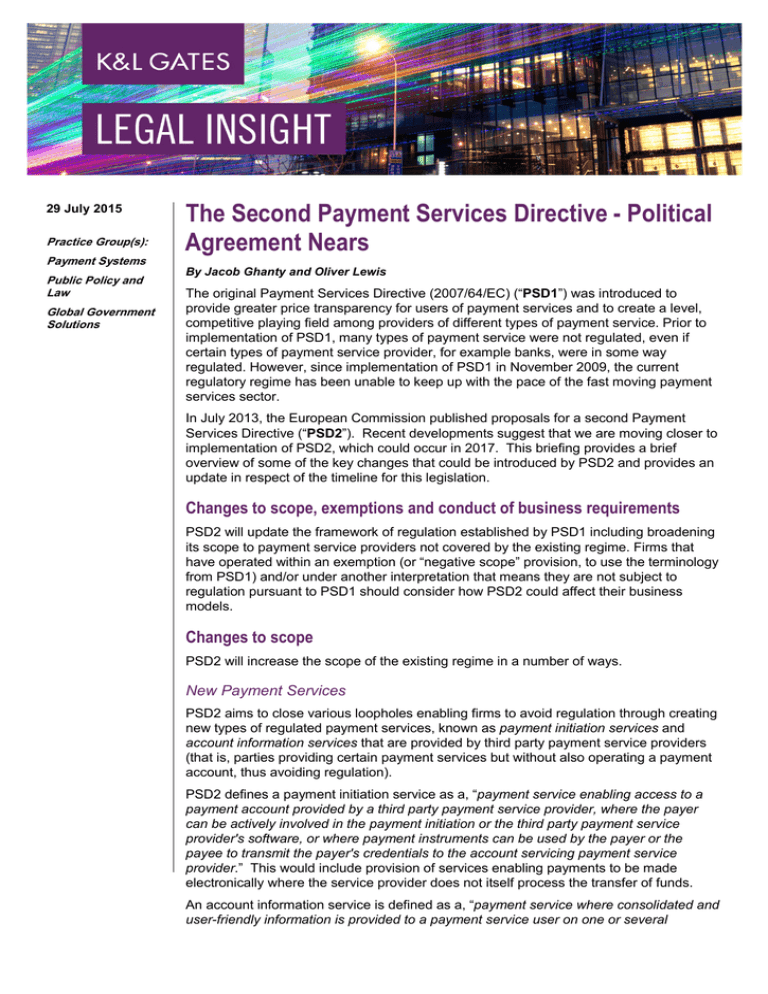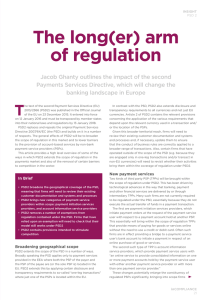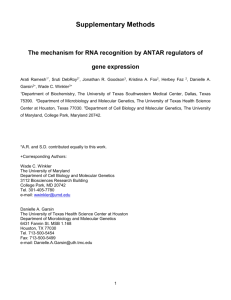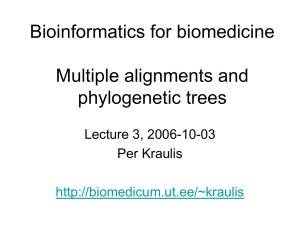
29 July 2015
Practice Group(s):
Payment Systems
Public Policy and
Law
Global Government
Solutions
The Second Payment Services Directive - Political
Agreement Nears
By Jacob Ghanty and Oliver Lewis
The original Payment Services Directive (2007/64/EC) (“PSD1”) was introduced to
provide greater price transparency for users of payment services and to create a level,
competitive playing field among providers of different types of payment service. Prior to
implementation of PSD1, many types of payment service were not regulated, even if
certain types of payment service provider, for example banks, were in some way
regulated. However, since implementation of PSD1 in November 2009, the current
regulatory regime has been unable to keep up with the pace of the fast moving payment
services sector.
In July 2013, the European Commission published proposals for a second Payment
Services Directive (“PSD2”). Recent developments suggest that we are moving closer to
implementation of PSD2, which could occur in 2017. This briefing provides a brief
overview of some of the key changes that could be introduced by PSD2 and provides an
update in respect of the timeline for this legislation.
Changes to scope, exemptions and conduct of business requirements
PSD2 will update the framework of regulation established by PSD1 including broadening
its scope to payment service providers not covered by the existing regime. Firms that
have operated within an exemption (or “negative scope” provision, to use the terminology
from PSD1) and/or under another interpretation that means they are not subject to
regulation pursuant to PSD1 should consider how PSD2 could affect their business
models.
Changes to scope
PSD2 will increase the scope of the existing regime in a number of ways.
New Payment Services
PSD2 aims to close various loopholes enabling firms to avoid regulation through creating
new types of regulated payment services, known as payment initiation services and
account information services that are provided by third party payment service providers
(that is, parties providing certain payment services but without also operating a payment
account, thus avoiding regulation).
PSD2 defines a payment initiation service as a, “payment service enabling access to a
payment account provided by a third party payment service provider, where the payer
can be actively involved in the payment initiation or the third party payment service
provider's software, or where payment instruments can be used by the payer or the
payee to transmit the payer's credentials to the account servicing payment service
provider.” This would include provision of services enabling payments to be made
electronically where the service provider does not itself process the transfer of funds.
An account information service is defined as a, “payment service where consolidated and
user-friendly information is provided to a payment service user on one or several
The Second Payment Services Directive - Political
Agreement Nears
payment accounts held by the payment service user with one or several account
servicing payment service providers.” This would include services, for example, enabling
people to have a consolidated view of their online bank accounts and/or facilitating
access to those accounts.
Geographical Scope of the Payments Regime
The existing payment services regime established by PSD1 applies only where the
payer’s payment service provider and the payee’s payment service provider are, or the
sole payment service provider in the payment transaction is, located in the EU. Thus, it
has been possible for businesses outside the EU to provide payment services to EU
citizens without being subject to most of the requirements of PSD1.
Pursuant to PSD2, certain provisions which relate principally to transparency of terms
and conditions and disclosure of information will apply to so-called “one-leg transactions,”
where only one of the payment service providers is in the EU.
Currencies
PSD2 will extend PSD1 provisions on transparency and disclosure of information to apply
to transactions in any currency, in contrast with the current regime, which applies only to
currencies of the EU.
Exemptions
PSD2 contains proposals to remove or restrict a number of exemptions under PSD1,
including as follows.
Commercial agents exemption: PSD1 does not apply to, “[p]ayment transactions from the
payer to the payee through a commercial agent authorised to negotiate or conclude the
sale or purchase of goods or services on behalf of the payer or the payee.” This
exemption has been relied upon by electronic trading platforms that handle payment
transactions on behalf of payers and payees. PSD2 will restrict the availability of the
commercial agents exemption to where the agent acts for either the payer or the payee,
but not both.
ATM networks: PSD2 will remove the exemption pursuant to which operators of ATMs,
who are not party to a framework contract with a payment service user, can provide cash
withdrawal services. Some of these independent networks have grown large and deal
with substantial volumes of cash transactions for which consumers can be charged high
fees.
Limited network exemption: PSD1 does not apply to, “services based on instruments
that can be used to acquire goods or services only in the premises used by the issuer or
under a commercial agreement with the issuer either within a limited network of service
providers or for a limited range of goods or services.” The Commission believes that this
exemption has been relied upon by large networks processing significant volumes of
payment transactions. PSD2 attempts to restrict this exemption.
Under PSD2, to fall within this exemption services will need to be based upon specific
instruments that are designed to address precise needs that can be used only in a limited
way. Also, where the monthly volume of transactions exceeds EUR 1 million, the
payment service provider will need to seek clearance from the relevant regulator.
2
The Second Payment Services Directive - Political
Agreement Nears
Conduct of business requirements
PSD2 makes a number of changes to the conduct of business requirements of PSD1,
including the following.
Safeguarding of customer funds: PSD2 will remove Member States’ option to derogate
allowing them to disapply safeguarding requirements for customers with funds balances
of EUR 600 or less.
Refunds: PSD2 contains a proposal which would bring the right for a refund for direct
debit transactions into conformity with the SEPA core direct debit scheme, by granting
the payer an unconditional right to a refund within eight weeks of the debit date.
Liability for unauthorised transactions: PSD2 contains a proposal which would reduce the
liability of payment service users for unauthorised payment transactions. The maximum
amount a payment user could under the proposals be required to pay in respect of an
unauthorised payment transaction would be EUR 50 (under the current regime the figure
is EUR 150).
Next Steps and Implementation
At a meeting of the European Parliament, the European Council and the Commission
held on 2 June 2015, political agreement was reached on the final compromise text of
PSD2.
The next step is for PSD2 to be adopted formally by the Parliament and the Council,
pursuant to which it will be published in the Official Journal of the EU. PSD2 will come
into force 20 days after the text has been published in the Official Journal. It is not clear
at present precisely when PSD2 will be adopted and come into force. However, once
PSD2 does come into force, Member States will be obliged to transpose it into their
national laws within two years. It is currently, therefore, expected that PSD will need to
be implemented into national law during 2017.
Authors:
Jacob Ghanty
Oliver Lewis
Jacob.Ghanty@klgates.com
+44.(0).20.7360.8211
Oliver.Lewis@klgates.com
+44.(0).20.7360.8241
Anchorage Austin Beijing Berlin Boston Brisbane Brussels Charleston Charlotte Chicago Dallas Doha Dubai Fort Worth Frankfurt
Harrisburg Hong Kong Houston London Los Angeles Melbourne Miami Milan Moscow Newark New York Orange County Palo Alto
Paris Perth Pittsburgh Portland Raleigh Research Triangle Park San Francisco São Paulo Seattle Seoul Shanghai Singapore
Spokane Sydney Taipei Tokyo Warsaw Washington, D.C. Wilmington
K&L Gates comprises more than 2,000 lawyers globally who practice in fully integrated offices located on five
continents. The firm represents leading multinational corporations, growth and middle-market companies,
capital markets participants and entrepreneurs in every major industry group as well as public sector entities,
educational institutions, philanthropic organizations and individuals. For more information about K&L Gates or
its locations, practices and registrations, visit www.klgates.com.
This publication is for informational purposes and does not contain or convey legal advice. The information herein should not be used or relied upon
in regard to any particular facts or circumstances without first consulting a lawyer.
© 2015 K&L Gates LLP. All Rights Reserved.
3






